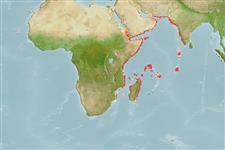Teleostei (teleosts) >
Eupercaria/misc (Various families in series Eupercaria) >
Sciaenidae (Drums or croakers)
Etymology: Otolithes: Greek, ous, oto = ear + Greek, lithos = stone (Ref. 45335).
Eponymy: Georges Léopold Chrétien Frédéric Dagobert Baron Cuvier (1769–1832), better known by his pen name Georges Cuvier, was a French naturalist and one of the scientific giants of his age. [...] (Ref. 128868), visit book page.
More on author: Trewavas.
Environment: milieu / climate zone / depth range / distribution range
Ecology
Marine; benthopelagic. Tropical
Western Indian Ocean: coasts of India and Pakistan.
Length at first maturity / Size / Weight / Age
Maturity: Lm 24.5 range ? - ? cm
Max length : 39.0 cm TL male/unsexed; (Ref. 55968); common length : 20.0 cm TL male/unsexed; (Ref. 3490)
Inhabits inshore and coastal waters (Ref. 3490). Carnivorous feeder. Feeds on Acetes spp., penaeid prawns, deep-sea prawns, fishes, stomatopods, mollusks, isopods, copepods and fish larvae (Ref. 53464).
Lal Mohan, R.S., 1984. Sciaenidae. In W. Fischer and G. Bianchi (eds.) FAO species identification sheets for fishery purposes. Western Indian Ocean (Fishing Area 51). Vol. 4. FAO, Rome. pag. var. (Ref. 3490)
IUCN Red List Status (Ref. 130435: Version 2024-1)
Threat to humans
Harmless
Human uses
Fisheries: commercial
Tools
Can't connect to MySQL database fbquizv2. Errorcode: Too many connections
